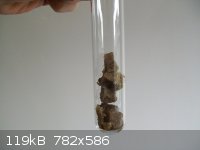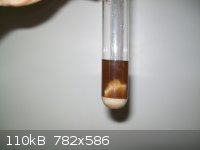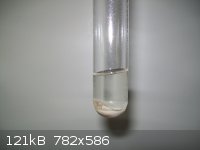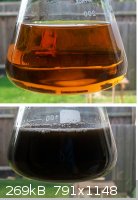| Pages:
1
2 |
IndependentBoffin
Hazard to Others
  
Posts: 150
Registered: 15-4-2011
Member Is Offline
Mood: No Mood
|
|
Drying out aqueous ammonium nitrate
As some of you might know NH4NO3 can be quite hard to get in the UK unless
you are a farmer or run a quarry.
I've been able to produce impure NH4NO3 through the metathesis of
Ca(NO3)2.4H2O and (NH4)2SO4, both of which are commonly
available as fertiliser.
My goal is to have the whole thing dry enough for use as ammonpulver solid rocket fuel, or 85% NH4NO3 and 15% C.
The problem is drying it and removing a brownish soluble contaminant in the system. Any advice from the experienced chemists to an amateur chemist
with an engineering background will be much appreciated.
Here are the steps I've taken:
1) Ca(NO3)2.4H2O has a molar weight
of 236.15 g/mol for the calcium nitrate tetrahydrate. It comes as white prills about 2-3mm in diameter as Yaraliva Tropicote Calcium Nitrate
fertiliser. It is dissolved fully in water.
2) (NH4)2SO4 has a molar weight of
132.14 g/mol. It comes as a moist brown crystalline salt of size ~0.5mm as Sinclair Sulphate of Ammonia. It looks like brown sugar and tastes spicy if
accidentally confused with brown sugar. It is also dissolved fully in water.
3) The two mixtures are added together at a mole fraction of 1:1. Immediately a white precipitate of CaSO4.2H2O forms.
4) The mixture is gravity filtered. A clear dark brown solution is produced (see picture)
5) I do not know why the solution is brown but presumably it is because there is an excess of (NH4)2SO4. I used stoichiometric amounts.
6) I tried drying the solution in a vacuum chamber (built professionally for about £400) that goes down to almost -1 atmosphere. Initially the
solution at room temperature boils, but absorbs heat of vapourisation and cools, then stops boiling until heat conducts into the chamber and raises
the solution's temperature.
7) I've tried boiling and sun-drying it. The former is energy intensive and the latter is slow and ends up full of other impurities (dirt, grass,
etc.)
My questions are:
1) How do I determine the impurities and their percentages in these fertilisers?
2) What is the principal impurity in the filtered solution?
3) How do I economically dry the solution?
4) For both the boiling and sun drying methods, eventually I have a wet mass of crystals. How much further can I heat it, bearing in mind my goal is
bone dry NH4NO3 suitable for rocket fuel (even dry NH4NO3 obtained from Instant Kool Paks used in Ammonpulver can sputter out unless
ignited by a very hot source). Ammonpulver quenched an igniting match head stuffed straight into it. It needed KNO3 + steel wool to start it going.
5) Is there any other way to purify the NH4NO3 apart from dissolving it in
methanol and drying it? I do have methanol but it isn't the safest chemical to have drying around the house in large quantities...
[Edited on 23-4-2011 by IndependentBoffin]
|
|
|
Picric-A
National Hazard
   
Posts: 796
Registered: 1-5-2008
Location: England
Member Is Offline
Mood: Fuming
|
|
Just for your personal reference, i completly disagree that NH4NO3 is hard to get in the UK!!
I buy 5kg sacks of the stuff from my local gardening/hardware shop or £5.99 a sack. I can also buy NaNO3, (NH4)2SO4, H3PO4, H2O2 and all sorts of
other chemicals from the same place. The NH4NO3 is in the form of white prills, which completly disolve in water giving a colourless solution. (which
shows it had no CaCO3 contaminents like some forms of prills do)
One can also obtain the stuff from ice packs, in around 50g quantities which cost around 99p each. More expencive i know but this is certainly
avaiable to everyone and is very pure NH4NO3.
|
|
|
hissingnoise
International Hazard
    
Posts: 3940
Registered: 26-12-2002
Member Is Offline
Mood: Pulverulescent!
|
|
| Quote: | | Just for your personal reference, i completly disagree that NH4NO3 is hard to get in the UK! |
Talking to cops about making explosives might just, er, complicate things for IB . . .
But contaminated NH<sub>4</sub>NO<sub>3 </sub> can be purified somewhat by cautiously heating to its melting point in
the hood.
Most of the phenolic contaminants will vapourise; some will be oxidised by nitrate.
If all else fails IB, look for a cleaner sulphate!
|
|
|
IndependentBoffin
Hazard to Others
  
Posts: 150
Registered: 15-4-2011
Member Is Offline
Mood: No Mood
|
|
Quote: Originally posted by Picric-A  | Just for your personal reference, i completly disagree that NH4NO3 is hard to get in the UK!!
I buy 5kg sacks of the stuff from my local gardening/hardware shop or £5.99 a sack. I can also buy NaNO3, (NH4)2SO4, H3PO4, H2O2 and all sorts of
other chemicals from the same place. The NH4NO3 is in the form of white prills, which completly disolve in water giving a colourless solution. (which
shows it had no CaCO3 contaminents like some forms of prills do)
One can also obtain the stuff from ice packs, in around 50g quantities which cost around 99p each. More expencive i know but this is certainly
avaiable to everyone and is very pure NH4NO3. |
Can you please let me know the name of the shop (PM or in the thread)?
Why can't I find any ammonium nitrate to buy online?
|
|
|
Picric-A
National Hazard
   
Posts: 796
Registered: 1-5-2008
Location: England
Member Is Offline
Mood: Fuming
|
|
Unfortunatly its an un-branded/loca shop here so there wont be another one like it but my point was im sure there are others that will sell chemicals
like that. Do you live in a city? Maybe then it might be a tad more challenging!
|
|
|
IndependentBoffin
Hazard to Others
  
Posts: 150
Registered: 15-4-2011
Member Is Offline
Mood: No Mood
|
|
What does fertiliser grade ammonium nitrate look like? Can you only tell from its NPK rating or does it actually say "Pure Ammonium Nitrate" on the
sack?
|
|
|
hissingnoise
International Hazard
    
Posts: 3940
Registered: 26-12-2002
Member Is Offline
Mood: Pulverulescent!
|
|
Ammonium nitrate will normally be rated 35-0-0.
But calcium ammonium nitrate (C.A.N.) may be easier to get than AN.
The clay coating the granules will need to be filtered out.
The IRA used C.A.N. for bombmaking as is, allegedly!
|
|
|
ldanielrosa
Hazard to Others
  
Posts: 124
Registered: 25-4-2007
Member Is Offline
Mood: transparent
|
|
It sounds like your ammonium sulfate is dirty. Try recrystallizing that before you start. When it's pure, it'll also be white.
|
|
|
IndependentBoffin
Hazard to Others
  
Posts: 150
Registered: 15-4-2011
Member Is Offline
Mood: No Mood
|
|
OK thanks I'll try to recrystallise my ammonium sulphate!
I can sell the following:
1) Various high purity non-ferrous metals - Ni, Co, Ta, Zr, Mo, Ti, Nb.
2) Alkex para-aramid Korean Kevlar analogue fabric (about 50% Du Pont's prices)
3) NdFeB magnets
4) High purity technical ceramics
|
|
|
redox
Hazard to Others
  
Posts: 268
Registered: 22-2-2011
Location: The Land of Milk and Honey
Member Is Offline
Mood: Chalcogenetic
|
|
For drying, you could desiccate with an appropriate agent in a desiccator bag, or you could just pour the solution into a wide-mouth bowl with a
stream of air blowing into it. It would evaporate in a two or three days.
May I ask, How many milliliters are you experimenting with here? 500 mL? 1000 mL?
My quite small but growing Youtube Channel: http://www.youtube.com/user/RealChemLabs
Newest video: Synthesis of Chloroform
The difference between chemists and chemical engineers: Chemists use test tubes, chemical engineers use buckets. |
|
|
IndependentBoffin
Hazard to Others
  
Posts: 150
Registered: 15-4-2011
Member Is Offline
Mood: No Mood
|
|
Would silica gel be an appropriate dessicator? Also, I have a professionally built vacuum chamber connected to an electric vacuum pump.
The following picture is the result of leaving the saturated solution of (NH4)2SO4 + Ca(NO3)2, with the CaSO4 precipitate filtered out, to dry in the
sun for many days. It is a moist brown crystalline salt that seems to boil at around 140C, absorbing latent heat of vapourisation. If you keep heating
it, it eventually melts into a brown liquid.

I still have no idea what the brown impurity from the (NH4)2SO4 is.
On dissolving the moist brown salt in methanol, an off white powder is produced while the brown contaminant remains in solution in methanol. So the
contaminant must be something that can dissolve in methanol. Not very helpful as so does NH4NO3!

If you guys think trying to dissolve it in acetone will help you identify the impurity, let me know. I do have some of that lying around.
[Edited on 26-4-2011 by IndependentBoffin]
I can sell the following:
1) Various high purity non-ferrous metals - Ni, Co, Ta, Zr, Mo, Ti, Nb.
2) Alkex para-aramid Korean Kevlar analogue fabric (about 50% Du Pont's prices)
3) NdFeB magnets
4) High purity technical ceramics
|
|
|
smuv
National Hazard
   
Posts: 842
Registered: 2-5-2007
Member Is Offline
Mood: Jingoistic
|
|
why not use aqueous ammonia instead of ammonium sulfate? Fert grade ammonium sulfate is extremely dirty. It even smells funny. The precip will now
be calcium hydroxide.
"Titanium tetrachloride…You sly temptress." --Walter Bishop
|
|
|
IndependentBoffin
Hazard to Others
  
Posts: 150
Registered: 15-4-2011
Member Is Offline
Mood: No Mood
|
|
So:
Ca(NO3)2 (aq) + 2NH4OH (aq) -> Ca(OH)2 (ppt) + 2NH4NO3 (aq)?
Where did the calcium hydroxide come from when methanol is added? If I reacted the stuff in stoichiometric amounts and filtered off the CaSO4 there
should barely be any dissolved Ca++ ions left.
Also, if there were dissolved Ca++ ions, where did the OH- ions come from to precipitate them out?
Is it a known fact that fertiliser grade ammonium sulphate is extremely dirty? What about fertiliser grade calcium nitrate?
Sorry for all the questions, not that I don't believe you, I am trying to learn from you.
I can sell the following:
1) Various high purity non-ferrous metals - Ni, Co, Ta, Zr, Mo, Ti, Nb.
2) Alkex para-aramid Korean Kevlar analogue fabric (about 50% Du Pont's prices)
3) NdFeB magnets
4) High purity technical ceramics
|
|
|
ScienceSquirrel
International Hazard
    
Posts: 1863
Registered: 18-6-2008
Location: Brittany
Member Is Offline
Mood: Dogs are pets but cats are little furry humans with four feet and self determination! 
|
|
i would try adding a few grams of finely powdered activated charcoal to the crude solution formed at 3), give it a good boil if you can, and then
filter it.
Charcoal takes out lots of glop and boiling will often make precipitates easier to filter.
|
|
|
IndependentBoffin
Hazard to Others
  
Posts: 150
Registered: 15-4-2011
Member Is Offline
Mood: No Mood
|
|
Would it be better to have a first pass filtration to remove the CaSO4 first? Otherwise won't the activated charcoal be just swamped by the CaSO4?
I tried dissolving it in acetone. Solution remains clear but an off white powder is seen at the bottom (see picture below)
I was planning on pulverising activated charcoal for my ammonpulver so that compound is definitely on my shopping list 

I can sell the following:
1) Various high purity non-ferrous metals - Ni, Co, Ta, Zr, Mo, Ti, Nb.
2) Alkex para-aramid Korean Kevlar analogue fabric (about 50% Du Pont's prices)
3) NdFeB magnets
4) High purity technical ceramics
|
|
|
ScienceSquirrel
International Hazard
    
Posts: 1863
Registered: 18-6-2008
Location: Brittany
Member Is Offline
Mood: Dogs are pets but cats are little furry humans with four feet and self determination! 
|
|
I have added activated charcoal to truely filthy mixtures. What it likes is big polar organic shit like tars. It will ignore the mainly totally
insoluble calcium sulphate and the ammonium nitrate. The fact that the glop dissolves in methanol is good from this point of view.
It is illegal but activated charcoal has been used to decolourise red diesel for agriculural use turning it in to white road, the people concerned
would then pocket the duty.
This was a major funding source for the IRA, along with other scams, the used charcoal was dumped often creating local pollution problems.
|
|
|
IndependentBoffin
Hazard to Others
  
Posts: 150
Registered: 15-4-2011
Member Is Offline
Mood: No Mood
|
|
Ah, that is very interesting. I always thought activated charcoal works by having a high surface area and trapping contaminants in its pores. It seems
my understanding is inconsistent with what you're saying that it ignores insoluble calcium sulphate and soluble ammonium nitrate.
So how does activated charcoal grab organic stuff like tars? By what mechanism does it work on?
Thanks also for the story about using activated charcoal to decolourise red diesel. Very interesting as well. Does it still work or is a different dye
used to counter this? N.B. I have a petrol car but find this very interesting academically.
I can sell the following:
1) Various high purity non-ferrous metals - Ni, Co, Ta, Zr, Mo, Ti, Nb.
2) Alkex para-aramid Korean Kevlar analogue fabric (about 50% Du Pont's prices)
3) NdFeB magnets
4) High purity technical ceramics
|
|
|
ScienceSquirrel
International Hazard
    
Posts: 1863
Registered: 18-6-2008
Location: Brittany
Member Is Offline
Mood: Dogs are pets but cats are little furry humans with four feet and self determination! 
|
|
I really do not know how it works but it has a greater affinity for things with more binding sites.
That is why it is used in aquaria, water filters, etc.
It takes out organic goo produced by the fish or trace contaminants in the water and leaves the water nice and clean with most of the minerals left.
If it just gobbled up everything indiscriminately it would be useless
|
|
|
pjig
Hazard to Others
  
Posts: 135
Registered: 25-5-2010
Member Is Offline
Mood: always learning
|
|
From some research I have found that Yara brand fert . uses a "anti-explosive" C.C.B. coal combustion byproducts to contaminate the fertilizer for
its missuses as a explosive making material.
Much time and money has gone into the making of a non-explosive fertilizer. This is so they can sell it on the market as a direct replacement for AN .
The nitrate is under 25% (15.5%)making it hard if not impossible to det when mixed with a fuel, as well as these dang CCB's that can not be filtered
out by conventional means.
The charcoal filtratration is a promising idea as well as using solvents to extract and separate out the goods.
It stinks that in some areas , such a cheap source for rocket composite fuel is now a really expensive regulated chem. 
[Edited on 26-4-2011 by pjig]
|
|
|
IndependentBoffin
Hazard to Others
  
Posts: 150
Registered: 15-4-2011
Member Is Offline
Mood: No Mood
|
|
How do CCBs prevent detonation of fertiliser? I would have thought any oxidisable material would just increase the -(delta H) and thus increase
sensitivity. Aluminium particles in ammonium nitrate certainly does the job of sensitisation.
By the way even if I filter out the brown gunk how am I going to dry the aqueous ammonium nitrate?
I can sell the following:
1) Various high purity non-ferrous metals - Ni, Co, Ta, Zr, Mo, Ti, Nb.
2) Alkex para-aramid Korean Kevlar analogue fabric (about 50% Du Pont's prices)
3) NdFeB magnets
4) High purity technical ceramics
|
|
|
pjig
Hazard to Others
  
Posts: 135
Registered: 25-5-2010
Member Is Offline
Mood: always learning
|
|
http://osdir.com/patents/Synthetic-resins/Anti-explosive-fer...
This patent show the reasons and the processes for this Anti-explosive coatings.
|
|
|
IndependentBoffin
Hazard to Others
  
Posts: 150
Registered: 15-4-2011
Member Is Offline
Mood: No Mood
|
|
Yeah, I now totally agree that activated carbon must be used to get rid of any gunk in the fertiliser to get higher purity AN.
I've placed an order for some activated carbon for aquarium filters and will let you all know how I get on.
I can sell the following:
1) Various high purity non-ferrous metals - Ni, Co, Ta, Zr, Mo, Ti, Nb.
2) Alkex para-aramid Korean Kevlar analogue fabric (about 50% Du Pont's prices)
3) NdFeB magnets
4) High purity technical ceramics
|
|
|
IndependentBoffin
Hazard to Others
  
Posts: 150
Registered: 15-4-2011
Member Is Offline
Mood: No Mood
|
|
I've bought some activated charcoal and added an equal volume to a saturated solution of ammonium sulphate (bottom flask). Edit, clarification: The
solution in the bottom flask is very dark but it is a saturated solution of ammonium sulphate only with no carbon added.
I kept the thing warm (about 50 - 60C) over and electric heater for a few hours and let it sit at room temperature for several more hours.
I then filtered it. The lighter brown solution is what I obtained (top flask).
So using activated charcoal to get rid of the gunk inside the fertiliser grade ammonium sulphate from Sinclair was only a partial success.

What about if I buy cheap white copier paper, put some sheets vertically in a solution of the ammonium nitrate + unidentified brown gunk....after a
few days I just scrape the white crystallised salt (ammonium nitrate) which should be at around the same height above the now dry salt bath, or cut
the portion with ammonium nitrate, redissolve, filter and dry it?
[Edited on 30-4-2011 by IndependentBoffin]
I can sell the following:
1) Various high purity non-ferrous metals - Ni, Co, Ta, Zr, Mo, Ti, Nb.
2) Alkex para-aramid Korean Kevlar analogue fabric (about 50% Du Pont's prices)
3) NdFeB magnets
4) High purity technical ceramics
|
|
|
ldanielrosa
Hazard to Others
  
Posts: 124
Registered: 25-4-2007
Member Is Offline
Mood: transparent
|
|
What scale do you need to work on for your use? You can clean your ammonium sulfate, but from the pictures it appears that it'll take some effort.
How far is the next fertilizer dealer?
I'm sorry I can't find my camera to show my results of the same reaction. Unfortunately (fortunately for me), my (NH4)2SO4 is probably cleaner than
yours so my results will not match yours with the same effort- but my ammonium sulfate was spilled on the floor from two different bags and I did
recrystallize some for use in other experiments so the before and after pictures would have some meaning here.
Anyway, the price of fertilizer should allow some waste in the spirit of obtaining a clean product. I may have missed something, but it appears that
you are cooking to dryness. By dissolving on hot cycles and harvesting on cold cycles you get a cleaner product while the contaminants concentrate.
True, you will need to dispose of the filthy liquor at some point, but it's still good fertilizer.
As for drying, I'm working on small scale so I don't feel bad about using sodium hydroxide as a desiccant.
|
|
|
IndependentBoffin
Hazard to Others
  
Posts: 150
Registered: 15-4-2011
Member Is Offline
Mood: No Mood
|
|
| Quote: | I'd like to be able to do at least one static rocket test a day for an invention I am prototyping. The propellant grain is kept under 100g for legal
reasons. I'm investigating different propellants - KNO3/sugar based, ammonium nitrate-carbon-aluminium-sulfur based and then moving on to chlorate,
perchlorate based once my electrolysis anodes are ready.
Rocket fuels using KNO3 as an oxidiser are easy to mix up and cast, so they can be stored separately.
Ammonium nitrate from fertiliser (especially if an aqueous metathesis reaction is involved) is quite a pain to purify and dry. I'd like to have just
under 100g dry + pure ammonium nitrate at any one time (bearing in mind ammonpulver propellant is 85% ammonium nitrate and 15% carbon) and say a kilo
in the pipeline of being dried and purified. I don't think impure, wet ammonium nitrate is classified as an explosive although I may stand to be
corrected.
[quoted]
I may have missed something, but it appears that you are cooking to dryness. |
I've tried different things - placing in a baking tray in the oven, baking tray over the embers of a BBQ, baking tray in the sun, small baking tray
with wet crystals in a larger baking tray with silica gel covered with clingfilm.
I guess I have a couple of questions here. I have looked around on Google but no luck.
1) Is indicator silica gel adequate as a dessicant? I have several kilos of it leftover from a separate project.
2) Is it possible to efficienctly recrystallise ammonium sulphate? It is incredibly soluble (70.6 g/100 mL (0 °C), 74.4 g/100 mL (20 °C), 103.8
g/100 mL (100 °C)) and its solubility only varies by about 30% over 100 Celcius.
3) Is it better to recrystallise the ammonium sulphate or the filtered ammonium nitrate? If the former is done, then two drying stages must be
performed and two stages for wastage incurred. Of course at the moment the ammonium sulphate is so impure I am probably not even reacting it with the
calcium nitrate stoichiometrically.
4) How is activated carbon best used? What volume ratio to the contaminated solution, should the contaminated solution be dilute, saturated or super
saturated? How many times can it be reused? Is it better to flush through the activated carbon many times with the same contaminated solution or to
just warm/boil it together for some time?
5) It seems from the patent quoted earlier that the contaminant is organic in nature. Does this mean it should support combustion (fuel for the fire,
so to speak) while it may inhibit detonation? In which case I don't need to bother purifying my ammonium nitrate at all.
Alright I am going to try to recrystallise some ammonium sulphate now. I'll also take a lot more pictures to document the process better.
I can sell the following:
1) Various high purity non-ferrous metals - Ni, Co, Ta, Zr, Mo, Ti, Nb.
2) Alkex para-aramid Korean Kevlar analogue fabric (about 50% Du Pont's prices)
3) NdFeB magnets
4) High purity technical ceramics
|
|
|
| Pages:
1
2 |